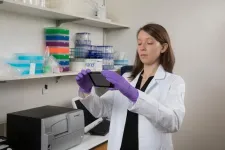(Press-News.org) The Harvard John A. Paulson School of Engineering and Applied Sciences (SEAS) and NTT Research, Inc., a division of NTT, announced the publication of research showing an application of machine-learning directed optimization (ML-DO) that efficiently searches for high-performance design configurations in the context of biohybrid robots. Applying a machine learning approach, the researchers created mini biohybrid rays made of cardiomyocytes (heart muscle cells) and rubber with a wingspan of about 10 mm that are approximately two times more efficient at swimming than those recently developed under a conventional biomimetic approach.
A team led by Harvard SEAS Postdoctoral Fellow John Zimmerman and including NTT Research Medical and Health Informatics Scientist Ryoma Ishii, Harvard SEAS Tarr Family Professor of Bioengineering and Applied Physics Kevin Kit Parker, and members of the Harvard SEAS Disease Biophysics Group led by Parker demonstrated this research in a new paper published in Science Robotics titled, “Bioinspired Design of a Tissue Engineered Ray with Machine Learning.”
“This research seeks to answer a fundamental question in the development of biohybrid robots, in this case the marine ray: How do we select fin geometries to operate under novel working environments while preserving natural scaling laws in terms of swimming speed and efficiency,” said Ishii, who also works as a visiting scientist for Harvard University. “Our research indicates the application of ML-DO, inspired by protein engineering, offers a more efficient and less computationally intensive path forward in automating the creation of muscular structure-function relationships.”
Limitations of the Biomimetic Approach
In biomimetic design, the conventional approach to biohybrids, engineers form functional devices by recreating existing biological structures. That approach, however, has limits. For biohybrid lifeforms that resemble batoid fishes (skates and rays), for example, there is a wide range of natural aspect ratios and fin morphologies. Which ones do you mimic? Also, biomimetics may neglect the natural biomechanical and hydrodynamic forces that govern how fast an organism can swim based on its size and body kinematics, leading to inefficient muscle mass and limited swimming speeds.
In that light, the motivating question in this study became: How to select fin geometries that operate under novel working environments while preserving natural scaling laws in terms of swimming speed and efficiency?
The Design Breakthroughs of Machine Learning
The multi-disciplinary and iterative nature of the problem required computationally intensive modeling, but the team believed that directed optimization by machine learning (ML-DO) would enable an efficient search for fin designs that maximized their relative swimming speeds. They based their hypothesis in part on a trial function that demonstrated an approximately 40 percent improvement of ML-DO over other leading methods in recognizing known high-rank sequences. Testing the assumption involved three steps: 1) developing an algorithm for expressing a multitude of different fin geometries; 2) describing a generalized ML-DO approach for searching within a large discontinuous configuration space; and 3) using this methodology to identify biohybrid fin geometries for high-performance swimming with smooth and orderly flow.
The ML-DO-driven results included a quantitative exploration of fin structure-function relationships and reconstruction of general trends in open-sea batoid morphology, as well as a winning design: Fins with large aspect ratios and fine tapered tips, which preserved their utility across multiple length-scales of swimming. On that basis, the team built biohybrid mini-rays out of engineered cardiac muscle tissue, which were capable of self-propelled swimming at the millimeter length scale and demonstrated improved swimming efficiencies approximately two times greater than observed in previous biomimetic designs.
Looking Ahead
While promising, researchers note that additional work is needed to completely match natural scaling laws. While the devices presented in this study demonstrated greater efficiency than other recent biomimetic designs, they were still slightly less efficient on average than naturally occurring marine lifeforms.
In the future, researchers expect to continue the development of biohybrid robotics for use cases including remote sensors, probes for dangerous working environments and as therapeutic delivery vehicles. Researchers believe that the ML-DO-informed approach better mimics the selective pressures of evolution, enabling them to better understand how biological tissues are shaped—both in a healthy physiology as well as the maladaptive pathophysiology of disease. Additionally, this research advances scientific understanding of 3D organ biofabrication, such as a biohybrid heart.
“The Harvard Biophysics Group entered into a joint research agreement with NTT Research two years ago aiming to fundamentally interrogate our understanding of cardiac physiology, with an eye towards advancing the development of biohybrid devices, including biohybrid robotics and biohybrid human heart,” Parker said. “This paper indicates the positive progress our shared research has achieved so far, and I am excited to see what the future of our collaboration has in store.”
In 2022, NTT Research and Harvard SEAS announced a three-year joint research agreement to engineer a model of the human heart, study fundamental laws of muscular pumps and apply joint findings to the development of a cardiovascular bio digital twin model.
END
NTT Research and Harvard scientists optimize biohybrid ray development with machine learning
Paper presents ML application that efficiently delivers high-performance design and 2x swimming efficiency compared to rays developed biomimetically
2025-02-13
ELSE PRESS RELEASES FROM THIS DATE:
Mapping connections in a neuronal network
2025-02-13
Harvard researchers have mapped and catalogued more than 70,000 synaptic connections from about 2,000 rat neurons, using a silicon chip capable of recording small yet telltale synaptic signals from a large number of neurons.
The research, published in Nature Biomedical Engineering, is a major advance in neuronal recording and may help bring scientists a step closer to drawing a detailed synaptic connection map of the brain.
Higher-order brain functions are believed to be derived from the ways brain ...
Study: Air pollution exposure late in pregnancy increases NICU admission risk
2025-02-13
BUFFALO, N.Y. – Air pollution caused by auto emissions, wildfires and other sources is problematic for many people. It’s of particular concern for pregnant people due to the impact pollutants can have on the fetus, especially in the final month before birth.
A new study from the University at Buffalo offers insight into air pollution’s effects during this vulnerable time by measuring neonatal intensive care unit (NICU) admissions and satellite-based air pollution data.
The researchers focused on common pollutants, such as nitrogen dioxide (NO2), which is caused primarily by the burning of fossil fuels in vehicles, industrial processes and power plants, and PM2.5, which ...
Engineers enable a drone to determine its position in the dark and indoors
2025-02-13
CAMBRIDGE, MA – In the future, autonomous drones could be used to shuttle inventory between large warehouses. A drone might fly into a semi-dark structure the size of several football fields, zipping along hundreds of identical aisles before docking at the precise spot where its shipment is needed.
Most of today’s drones would likely struggle to complete this task, since drones typically navigate outdoors using GPS, which doesn’t work in indoor environments. For indoor navigation, some drones ...
U-M materials scientist, chemical engineer elected into National Academy of Engineering
2025-02-13
Photos
Michigan Engineering professors Elizabeth Holm and Nicholas Kotov are among the newest members of the National Academy of Engineering—one of the highest honors bestowed on engineers in the United States.
"Elizabeth Holm and Nicholas Kotov have not only distinguished themselves as leaders in their fields, they have demonstrated the impact we can have as engineers, influencing how current and future generations of engineers solve problems and do their work," said Karen Thole, the Robert J. Vlasic Dean of Engineering at the University of Michigan College of Engineering.
"We applaud this significant honor, and look forward ...
Evolutionary tradeoffs: Research explores the role of iron levels in COVID-19 infections
2025-02-13
BINGHAMTON, N.Y. -- Your body is ground zero for a cellular arms race.
Your mitochondria, red blood cells and immune system rely on iron to function; so do invading viruses and bacteria. As your body evolves safeguards for this most critical resource, these safeguards select for invaders that can overcome them.
“Iron is physiologically useful in catalyzing reactions, such as binding oxygen, because it both donates and accepts electrons,” explained Binghamton University Associate Professor of Anthropology ...
Ecological Society of America selects 2025 EEE Scholars
2025-02-13
The Ecological Society of America (ESA) announces the 2025 cohort of ESA Excellence in Ecology (EEE) Scholars. This prestigious scholarship program celebrates and supports outstanding early- to mid-career Ph.D. ecologists from groups traditionally underrepresented in the scientific community.
This year’s EEE Scholars are: Elvira D'Bastiani, Postdoctoral Researcher at the University of California, Los Angeles; Gabriela Garcia, Assistant Professor at Northeastern University; Camille Griffith, Assistant Professor at Oglala Lakota College; and Estelí Jiménez-Soto, Assistant Professor at the University of South Florida.
“These exceptional scholars embody ...
U.S. stream network is longer during annual high-flow conditions
2025-02-13
Rivers and streams may look permanent, but their lengths can change dramatically with the seasons, according to a new study. It reports that stream networks in the United States expand up to five times their low-flow size during wet conditions. The findings offer the first large-scale insights into how water dynamically moves through landscapes and provide a framework for forecasting climate-driven changes in stream networks, particularly in response to increasing storminess. Traditionally regarded as ...
Seismic techniques reveal how intense storms in 2023 impacted aquifers in Greater Los Angeles
2025-02-13
Despite record rainfall in the region in early 2023, only a fraction of Southern California’s groundwater reserves has been replenished, researchers report. Their study, which leverages seismic noise data from across Greater Los Angeles, highlights the urgent need for improved monitoring and management of the state’s critical groundwater reserves. After enduring two decades of severe drought, California experienced an abrupt meteorological shift in water in 2023. A succession of 16 atmospheric rivers from late 2022 through early 2023, followed by the torrential ...
Elephant seals in the Pacific serve as deep-ocean sentinels, revealing patterns otherwise hard to measure
2025-02-13
Northern elephant seals may hold the key to unlocking the secrets of the open ocean’s twilight zone (~200 – 1,000 meters deep). According to a new study, these deep-diving creatures can help estimate fish abundance by providing a rare window into the elusive prey dynamics in one of the planet’s most mysterious and remote ecosystems. Ecosystems are dynamic, with resource fluctuations – natural or human-induced – shaping species interactions and food webs. These processes are well studied in terrestrial ecosystems but not in deep, open ocean ecosystems, ...
Depression linked with higher risk of long-term physical health conditions
2025-02-13
Adults with a history of depression gain long-term physical conditions around 30% faster than those without, according to research publishing February 13th in the open-access journal PLOS Medicine. Kelly Fleetwood of the University of Edinburgh, United Kingdom, and colleagues argue that their study suggests depression should be viewed as a ‘whole body’ condition, and integrated approaches should be used to manage mental and physical health.
Depression is the most common mental health condition and ...
LAST 30 PRESS RELEASES:
Myeloma: How AI is redrawing the map of cancer care
Manhattan E. Charurat, Ph.D., MHS invested as the Homer and Martha Gudelsky Distinguished Professor in Medicine at the University of Maryland School of Medicine
Insilico Medicine’s Pharma.AI Q4 Winter Launch Recap: Revolutionizing drug discovery with cutting-edge AI innovations, accelerating the path to pharmaceutical superintelligence
Nanoplastics have diet-dependent impacts on digestive system health
Brain neuron death occurs throughout life and increases with age, a natural human protein drug may halt neuron death in Alzheimer’s disease
SPIE and CLP announce the recipients of the 2025 Advanced Photonics Young Innovator Award
Lessons from the Caldor Fire’s Christmas Valley ‘Miracle’
Ant societies rose by trading individual protection for collective power
Research reveals how ancient viral DNA shapes early embryonic development
A molecular gatekeeper that controls protein synthesis
New ‘cloaking device’ concept to shield sensitive tech from magnetic fields
Researchers show impact of mountain building and climate change on alpine biodiversity
Study models the transition from Neanderthals to modern humans in Europe
University of Phoenix College of Doctoral Studies releases white paper on AI-driven skilling to reduce burnout and restore worker autonomy
AIs fail at the game of visual “telephone”
The levers for a sustainable food system
Potential changes in US homelessness by ending federal support for housing first programs
Vulnerability of large language models to prompt injection when providing medical advice
Researchers develop new system for high-energy-density, long-life, multi-electron transfer bromine-based flow batteries
Ending federal support for housing first programs could increase U.S. homelessness by 5% in one year, new JAMA study finds
New research uncovers molecular ‘safety switch’ shielding cancers from immune attack
Bacteria resisting viral infection can still sink carbon to ocean floor
Younger biological age may increase depression risk in older women during COVID-19
Bharat Innovates 2026 National Basecamp Showcases India’s Most Promising Deep-Tech Ventures
Here’s what determines whether your income level rises or falls
SCIE indexation achievement: Celebrate with Space: Science & Technology
Children’s Hospital Colorado performs region’s first pediatric heart and liver dual organ transplant
Australian team discover why quantum computers have memory problems over time
What determines the fate of a T cell?
Candida auris: genetic process revealed which could be treatment target for deadly fungal disease
[Press-News.org] NTT Research and Harvard scientists optimize biohybrid ray development with machine learningPaper presents ML application that efficiently delivers high-performance design and 2x swimming efficiency compared to rays developed biomimetically




